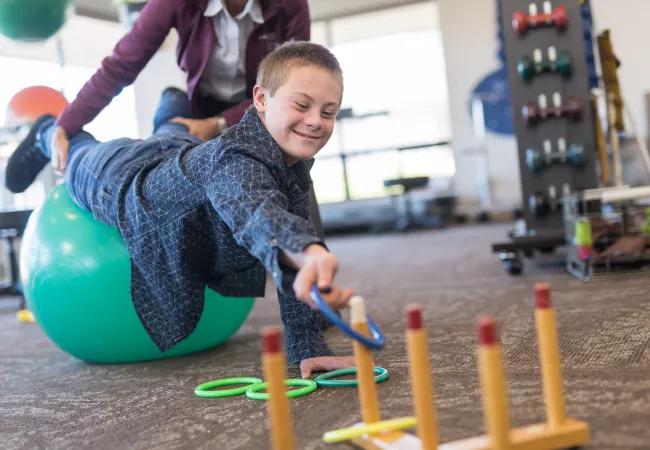Gains reported in cognition, coordination and balance in just six weeks

Do you have patients who are struggling to reach certain goals due to a possible lack of connections between brain structures? Are some of your patients beginning to plateau in their occupational, physical or speech therapy programs? A multisensory training program, offered as a component of occupational therapy at Cleveland Clinic Children’s, could give these patients the extra boost they need to make greater gains in cognition, coordination and balance.
Advertisement
Cleveland Clinic is a non-profit academic medical center. Advertising on our site helps support our mission. We do not endorse non-Cleveland Clinic products or services. Policy
Interactive Metronome® (IM) is an evidenced-based program that challenges patients to synchronize a range of whole-body exercises to a computer-generated beat, which helps improve attention, concentration, motor planning and sequencing. Cleveland Clinic Children’s has been offering this therapy to pediatric patients since 2014.
Merianna Satariano, OTR/L, Cleveland Clinic Children’s Therapy Services, Medina, uses IM to treat select patients from 18 months to 21 years of age. “As occupational therapists, we can customize the program based on the patient’s interests and specific needs,” she explains. “We use this information to determine how to best prepare the patient for treatment and provide assistance during the sessions.”
Satariano and her colleagues use a wide arrange of sensory equipment and strategies to keep patients engaged. “The IM unit includes on-screen games to keep help keep the children interested and provide them with feedback,” she says. “But we can also modify the environment to cater to the child’s needs and interests. So if the child likes baseball, we provide a bat for the child to tap against the foot tap mat, which is more engaging than just using the hands or feet. For a sensory seeking child, we can provide the child with sensory breaks in between IM tasks, such as jumping on a trampoline or rolling on a ball.”
The program can also be modified to be more challenging for individuals who are beginning to gain rhythm. “For example, we can have the child work on cognitive tasks (puzzles, card games, reading/writing) while tapping to the beat using foot tap mat.”
Advertisement
IM activates the structures of the brain related to timing, namely the dorsolateral prefrontal cortex, basal ganglia, cingulate gyrus and cerebellum, and it engages the connectivity between them. The repetition of IM tasks reinforces neurological pathways.
“When you can fire these neurological patterns and they become activated, you have a greater potential to access these neural networks more readily,” explains Satariano. “This can result in improvements in a patient’s ability to maintain attention, coordinate movements, express and understand language, read and write, and control impulses and behaviors.”
IM is used as a standalone, intensive program for four to six weeks of treatment. Therapists conduct three sessions per week, with sessions lasting 45–60 minutes. “IM is a good option for families who are unable to commit to long-term therapy programs, or for patients who are having difficulty attaining their individual goals in therapy.”
Cleveland Clinic Children’s currently offers IM at the following sites: Beachwood, Middleburg Heights, Medina, Stow and Westlake. The IM treatment system includes a main station that connects to a computer, a pair of headphones for auditory feedback, one or more triggering devices and the IM Universe software. The only requirement for patients is that they wear a pair of tennis shoes.
Since implementing IM, Satariano and her colleagues have seen patients between the ages of 18 months to 21 years make improvements in the following areas:
In the majority of cases, gains are maintained and additional functional progress is reported at follow-up. The program can be repeated for some children as they grow and develop. Patients who return to outpatient therapy after IM usually continue to make gains.
Advertisement
Satariano had been working with an 8-year-old patient with ASD, who was having difficulty making gains in therapy. Goals for the patient included:
The patient’s mother was especially hopeful that IM would help him respond to questions more immediately. “He would get fixated on one thing, which made it difficult to have a conversation with him,” Satariano recalls.
After completing the IM program, the patient started responding to questions almost immediately, making appropriate comments on a daily basis.
It was also rewarding for Satariano to see how he improved with hand-over-hand assist. “Throughout most of the program, he needed me to do hand-over-hand assist to activate the trigger,” she reveals. “But then he started doing more on his own and asking for help when he recognized he needed it. So his problem-solving skills were improving as he was more aware of his mistakes and what he needed to do to correct his errors.”
“As a team, we regularly discuss the needs of our patient populations to determine areas that require development,” Satariano explains. “Cleveland Clinic offers continuing education courses, webinars and research articles to encourage therapists to use evidenced-based practice in clinical decision-making with all patients. The organization provides access to training for both occupational and physical therapists who are interested in becoming IM providers.”
Advertisement
Advertisement

Integrated care model reduces length of stay, improves outpatient pain management

A closer look at the impact on procedures and patient outcomes

Experts advise thorough assessment of right ventricle and reinforcement of tricuspid valve

Study also finds that 26% of children with cancer have mutations in DNA repair genes

A closer look at current uses and future opportunities

Experts are challenging the one-size-fits-all paradigm

Quality improvement project addresses unplanned extubation

Cardiac imaging substudy is the latest paper originating from the VANISH trial